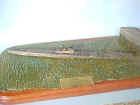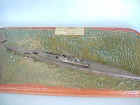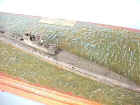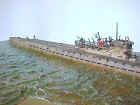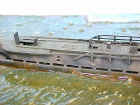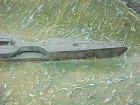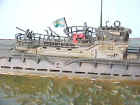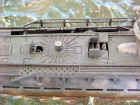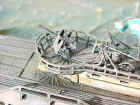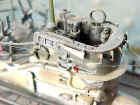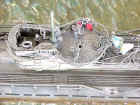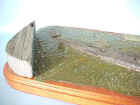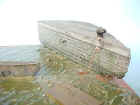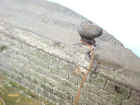 |
|
|
Ships
|
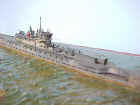
|
|
U-530, an Argentine gray wolf
|
|
by Ariel E. Pelayo info@modelersite.com
|
|
English text by Mario Covalski
|
|
History
On May 5th 1945 at 8.30 AM, Germany ceased the combat in all battle fronts, Admiral Karl Doenitzt assumed the surrender's responsibility and radiated to the submarines the special order (n° 0953/4) in which he assumed "Germany has been defeated".
|
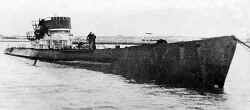
U530 in the Mar del Plata harbor
Photo newspaper "La Prensa"
|
Once this news was known by the Captains, " rainbow " operation, which would sink the submarine fleet by themselves, began.
When High Allied Command knew this fact, demanded from the Admiral to put an end to the ships' destruction, performing the surrender's conditions.
On May 6th and from Flensburgo, Doenitz sent the prohibition of sinking the ships.
On June 10th in the morning, that is to say 36 days later and at a few miles from the "Mar Del Plata" city harbor coast in Argentina, emerged the Germany fleet's submarine U-530, to discard part of its armament; when this task finished, the boat immersed again and went on navigating to emerge then at 4000 meters from the coast.
At 7.30 AM, and for more than 15 minutes the German commander Lieutenant OTTO VERMOUTH exchanged messages with the Argentina Navy Base's chief "Capitan de Corveta" (Captain) RAMON SAYUS, after identifying his ship as the U-530, the German commander informed that he wanted to surrender peacefully.
Once his request was accepted, the U-530 renewed its course until stopping next to the Coast Guard "General Belgrano".
After this, the surrendered Captain joined his crew and were notified that they were prisoners of war. A few days later, on July 12th, after a simple ceremony the Lieutenant gave the boat to the Argentine Navy hoisting then the Argentine flag.
The model
I chose the Nichimo kit which represents the IX -B (U107), or IX-C version in 1/200 scale. It also exists a kit from Monogram (N3102) and the Hasegawa 1/700 water line.
The Nichimo kit is more detailed, besides I wanted to build a different version, so I would have to modify the whole ship; that's why I chose the best.
Here you have some of the most important modifications I had to make.
I made cuts on the prow following the modifications that were made on 16 type IX U-Boat (the U530 was one of them).
I opened and thinned scuttles on the deck.
 I eliminated the torpedo's recharge cover in the stern, (the A and B type were curve) I eliminated the torpedo's recharge cover in the stern, (the A and B type were curve)
 The holes for free water circulation were opened. The holes for free water circulation were opened.
 I scratch built a new support for the drag rope. I scratch built a new support for the drag rope.
 I drilled all bitts, eight in short. I drilled all bitts, eight in short.
 I made new exhausts on the port and starboard. I made new exhausts on the port and starboard.
 The openings made on deck were detailed (actually exists very good photographic references). The openings made on deck were detailed (actually exists very good photographic references).
 I paid special attention to the whole snorkel assemble, since the kit doesn't provide it. I built it with stretched sprue which I sanded to give it the right shape. I paid special attention to the whole snorkel assemble, since the kit doesn't provide it. I built it with stretched sprue which I sanded to give it the right shape.
 I worked first on the tower extension, then I detailed its interior, deck, rest feet (and their supports), entrance doors, anti spray sheets, ( the kit didn't have some of them), snorkel support, handrails and drails, armament supports and shields. I worked first on the tower extension, then I detailed its interior, deck, rest feet (and their supports), entrance doors, anti spray sheets, ( the kit didn't have some of them), snorkel support, handrails and drails, armament supports and shields.
 Grills for diesel engines' air suction. Grills for diesel engines' air suction.
After this I paid my attention to the paint job, I began giving to the whole model a medium gray base layer. To simulate the typical "U-booten" paint shelling (at the end of the war) I used the technique of applying white glue or mask liquid, and after painting it I peeled off the masking material.
After masking several areas which were more wear exposed, I painted the whole ship in dark green, when this layer was dried I removed the small masks showing then the gray base color.
The final effect is as if you were seeing an uneven green peeled paint.
I waited until all this was dry (24 hrs. more or lees) and I began with the rust and drip effects so characteristic on the submarines of that period.
I used the dry brush and washes techniques with the following colors: ocher, red, green, gray and black, all of them well diluted ( alcohol plus water ) acrylics.
The Diorama
I made a mold of the dock, then I filled it with plaster, when it dried I carved it with a needle or a punch. After this I painted the whole part using a brush with light gray paint.
For the water surface I used putty for walls. I beat it on an irregular way ( remember that it is calm harbor water), then I painted it with several shades of green (to achieve the typical stains of the harbor water). Once all this was dried, I placed the model on, and I poured on different places of the surface a lot of clear marine varnish, until getting a thickness from 3 to 4 mm.
Conclusion
For this project it was very important to collect photos and information from that time. The weathering is the key for the model aspect and for this we need to know how the subject really was.
Consulted Sources
 Máquinas de guerra, N'62. Submarinos del eje AMT. U-Boat con pabellón Argentino. (Raul Forte) Diario "LA NACION" 8/8/95 (Emesto Caslrilion) Máquinas de guerra, N'62. Submarinos del eje AMT. U-Boat con pabellón Argentino. (Raul Forte) Diario "LA NACION" 8/8/95 (Emesto Caslrilion)
 Todo es Historia N'72 abril '73 Todo es Historia N'72 abril '73
 The tipe IX U-Boat by Robert W. Thew The tipe IX U-Boat by Robert W. Thew
 The U-Boat ( Sigfried Breyer), vol.2 The U-Boat ( Sigfried Breyer), vol.2
 Revista Todo Modelismo. Revista Todo Modelismo.
 U-Boat in Action (Squadron) U-Boat in Action (Squadron)
 Das Grobebilbuch der Deutschen 1939/45 (Cajus Bekker) Das Grobebilbuch der Deutschen 1939/45 (Cajus Bekker)
|



